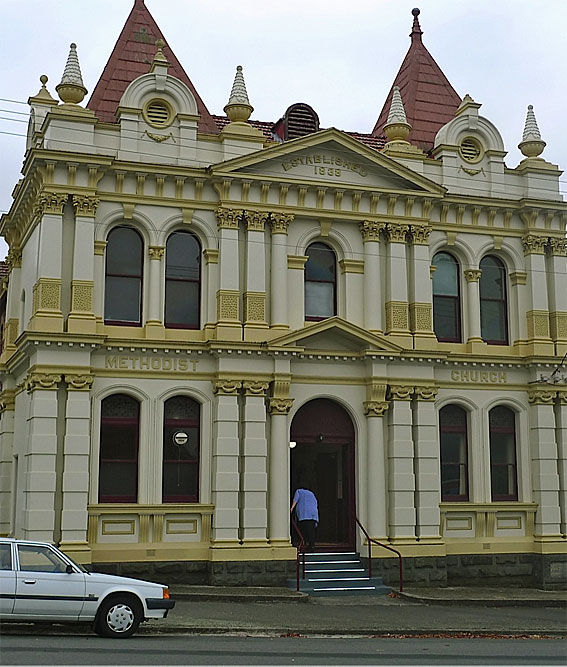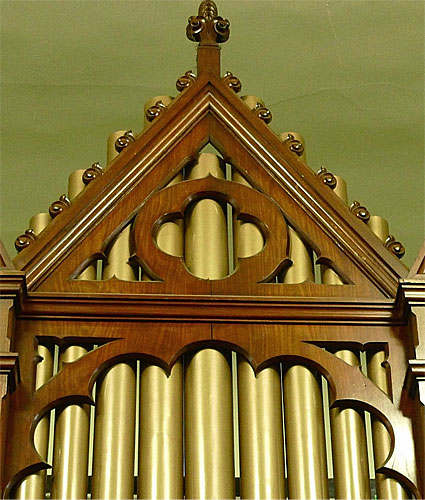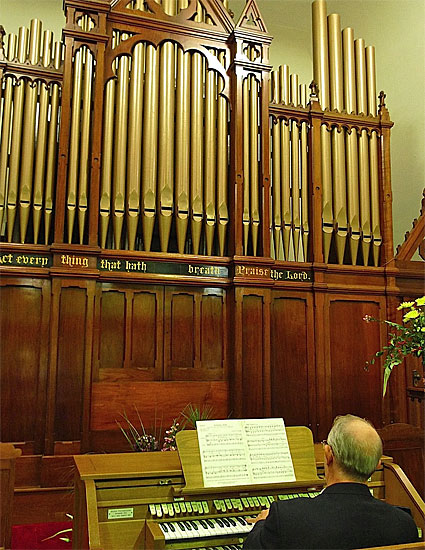Trinity Uniting (Methodist) Church
Margaret Street, Launceston
B. 1880 George Fincham. Inst. present loc. 1914 from
Methodist Church, Paterson Street, Launceston.
Reb. 1920 Geo. Fincham & Sons. 2m., 21 sp.st., 3c., tub.pn.
Gt: 8.8.8.8.4.4.2-2/3.2. Sw: 16.8.8.8.8.4.II.8.8.8. Ped: 16.16.8.
Reb. c.1975 K.R. Davis & Son; overhauled 1987 Australian Pipe Organs.
2m., 25 sp.st., 7c., el.pn.
Gt: 8.8.8.8.4.4.2-2/3.2. Sw: 16.8.8.8.8.4.2.II.8.8.
Ped: 16.16.8.8.5-1/3.4.4.2.
Historical and Technical Documentation by John Maidment
© OHTA (last updated May 2011)

Trinity Uniting Church, Launceston : exterior from south
[photograph by Peter Dowde (9 January 2011)]

Trinity Uniting Church, Launceston : exterior from south
[photograph by Trevor Bunning (29 April 2011)]

Trinity Uniting Church, Launceston : interior with organ
[photograph by Trevor Bunning (29 April 2011)]
The first plan for a church on this site appeared in January 1837; this was a small wooden structure erected for £250. The building was later enlarged to the designs of local architect Peter Mills and built by contractors Messrs. Lloyd & Douslin. This consisted of a Chapel and Sunday School and was opened on 31 October 1858.1
In June 1889 a new Wesleyan Sunday School building was opened, which was designed and built by Messrs J. & T. Gunn.2 The building has a distinctive Classical facade, with diminutive twin towers, almost in a mannerist idiom, crowded with architectural detail. This building was also used as a church, known as Margaret Street Methodist Church.
On 23 April 1917 a scheme was launched to remodel the Sunday School as a church. The architect was Harold Masters and the contractors were Hinman, Wright and Manser. It was opened on 27 January 1918. An extension was made to the building to accommodate the organ.3 Earlier, in 1911, Alexander North had provided plans for an entirely new church building in a very progressive style resembling his later Trinity College Chapel at the University of Melbourne.

Organ shown in its original home at the Methodist Church, Paterson Street, Launceston
[photograph by Trevor Bunning from original held by Pilgrim Uniting Church (29 April 2011)]
The organ was built by George Fincham for the Wesleyan Church, Paterson Street, Launceston and was opened there in June 1880. A contemporary description read:
The organ, which was built by Mr G. Fincham, of Melbourne, contains two manuals, viz. Great organ with a compass from CC to G of 56 notes, and swell organ of the compass from CC to G of 56 notes. The bellows are of ample dimensions, containing double feeders, with inverted ribs and improved pallets, etc. The swell box is double lined, the space between the inner and outer lining being filled in with sawdust. There is also a separate pedal sound board, a radiating and concave pedal clavier, the compass being from C to F of 30 notes. There are also composition pedals for combinations. The anti-concussion valves are attached to the swell and great sound boards. The organ front is constructed of blackwood, French polished, and is of a most handsome design. In the centre of the woodwork and over the covering of the keys is fixed a silver plate from the Grubb gamily, in affectionate remembrance of the late Hon. W.D. Grubb. The front pipes are illuminated in blue and gold, and give a very pretty effect to the instrument. The case ends are of deal, stained and varnished to match the blackwood front. The organ contains the following stops : - Great organ: open diapason (metal), CC to G, 56 pipes, 8ft; stop diapason, bass clarabella (wood) CC to G, 56 pipes, 8ft ; dulciana (metal), CC to G, 56 pipes, 8ft; principal (metal), CC to G, 56 pipes, 4ft; flute (wood), CC to G, 56 pipes, 4ft; 6 twelfth (metal), cc to G, 56 pipes, 22/3ft; 7 fifteenth (metal), CC to G (56 pipes), 2ft. Swell organ : double diapason (wood), CC to G, 56 pipes, 16ft. tone; open diapason (metal and wood), CC to G, 56 pipes; stop diapason (wood), CC to G (56 pipes), 8ft; keraulophon (metal), tenor C to G, 44 pipes, 8ft ; principal (metal), CC to G (56 pipes), 4ft ; mixture (metal), CC to G, 112 pipes, two ranks; oboe (metal), CC to G. 56 pipes, 8ft. Pedal Organ – Pedal open diapason (wood), CCC to F, 30 pipes, 16ft; pedal Bourdon (wood), CCC to F, 30 pipes, with couplers, swell to great, swell to pedal, and great to pedal. There are also three composition pedals to great organ, and two to swell organ. The number of drawstops is 19, and the number of pipes in the organ, 888. A somewhat novel feature to the organ, and we believe the only one in use in Tasmania, is that the bellows are blown by a hydraulic engine.4
The specification of the organ, recorded in 1970, read:
GREAT
Open Diapason
Open Diapason
Claribel
Dulciana
Principal
Flute
Twelfth
Fifteenth
Swell to Great
SWELL
Double Diapason
Open Diapason
Stop Diapason
Gamba
Voix Celeste
Principal
Mixture 17.19
Cornopean
Oboe
Vox Humana
Tremulant
PEDAL
Open Diapason
Bourdon
Bass Flute
Great to Pedal
Swell to Pedal5
|
8
8
8
8
4
4
2-2/3
2
16
8
8
8
8
4
II
8
8
8
16
16
8
|
large, on separate chest, 1920
1920
1920 TC
1920
1920
A
A 1920
|

Trinity Uniting Church, Launceston – organ from gallery
[photograph by Trevor Bunning (29 April 2011)]

Trinity Uniting Church, Launceston – organ from floor
[photograph by Trevor Bunning (29 April 2011)]

Trinity Uniting Church, Launceston – detail of organ case
[photograph by Trevor Bunning (29 April 2011)]

Trinity Uniting Church, Launceston – detail of organ case
[photograph by Trevor Bunning (29 April 2011)]

Trinity Uniting Church, Launceston – detail of organ case and console
[photograph by Trevor Bunning (29 April 2011)]
In 1975, the organ was rebuilt by K.R. Davis. The action and console were upgraded at this time to electro-pneumatic. Further work in 1987 by Australian Pipe Organs Pty Ltd, of Keysborough, Victoria, consisted of overhauling the slider windchests, tonal regulation and remaking of the 1920 Swell Cornopean as a Trumpet.
GREAT
Open Diapason no 1
Open Diapason no 2
Claribel
Dulciana
Principal
Flute
Twelfth
Fifteenth
Swell Sub Octave to Great
Swell to Great
Swell Octave to Great
SWELL
Double Diapason
Open Diapason
Stopped Diapason
Viola da Gamba
Viole Celeste
Principal
Flageolet
Mixture 19.22
Trumpet
Oboe
Tremulant
Swell Sub Octave
Swell Octave
PEDAL
Open Diapason
Bourdon
Principal
Bass Flute
Octave Quint
Fifteenth
Flute
Nachthorn
Great to Pedal
Swell to Pedal
|
8
8
8
8
4
4
2-2/3
2
16
8
8
8
8
4
2
II
8
8
16
16
8
8
5-1/3
4
4
2
|
A
1-12 new
TC
1-2 new
new
new
remade
B
A
B
B
A
B
A
|
Compass: 61/30
Detached stopkey console
Electro-pneumatic action6

Church during Harvest Festival
Photo supplied by Trevor Bunning (year unknown)
1 G. Ikin and Lewis E. Barnard, Margaret Street Methodist Church (Launceston: the church, 1938), p.6; details courtesy of the State Library of Tasmania
2 Launceston Examiner, 25 June 1889, p.3
3 The Mercury, 19 January 1918, p.15; pers.comm. Marion Sargent, Launceston Reference Library, January 2011
4 Launceston Examiner, 25 June 1880, p.2
5 Noted John Maidment 1970
6 Specification supplied by Robert Heatley, Australian Pipe Organs Pty Ltd, January 1995.









